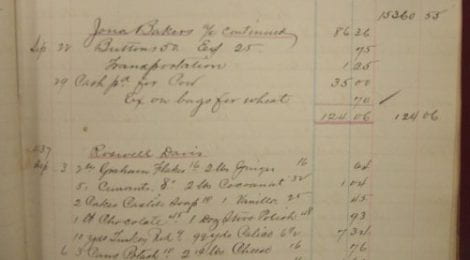
Town History in Financial Records
Those who live in the town of New Paltz are likely familiar with the names of the town’s major founders. Hasbrouck, Deyo, DuBois, Crispell, Lefevre—these names adorn buildings throughout the area, and until just recently represented several residence and dining halls here on the SUNY college campus. The fame these families garnered dates back to the town’s origins in 1677, though their powerful legacy transcended generations and resulted in them remaining the most dominant families of the region even in the late 19th century.
My internship work primarily consists of transcribing the Village of New Paltz’s tax records from the 1880’s. This task can be incredibly dry at times, with a seemingly endless sea of financial charts waiting to be logged into a spreadsheet. The oldest book I have access to is from 1888, and details over one hundred pages of such records. A board of trustees opens each financial year, giving specific details as to what the tax rates were for that year and how they were to be imposed. This board was initially what caught my interest, as I recognized several of the member’s surnames. Most notably in the case of Elting J. Deyo, who acted as an undersigned affirming the accuracy of the logs, and Jacob M. Hasbrouck, who was President of the Board.
As I began to read more into the tax records themselves, it became apparent that these surnames and others I recognized as major players in the town’s history dominated the economic sphere of New Paltz during this time frame. The majority of the purchases detailed in these logs are of small value, ranging between 10-50 dollars per transaction. (According to an inflation calculator found on officicaldata.org, that’s roughly the equivalent of 270-1350 dollars in today’s currency). However, the larger purchases followed a very consistent trend of almost always involving one of these recognizable names and usually occurring in large bursts. I characterize these purchases as ranging from 100-1000 dollars (2,700-27,000 in today’s currency), and noticed they tended to fall into the following categories: exchanges with the Huguenot National Bank and purchases of separate lots, village lots, new houses, or new shops. Separate and village lots were the most common of these, making empty land the biggest commodity.
Upon acquiring this information, I was curious as to why the sales occurred in this manner. I began to look further into the matter, and quickly learned that the time period I had been reviewing was an especially important moment of expansion for the town; more people moved to the town of New Paltz than any of the surrounding regions. As a result, by 1888 the town flourished with construction projects, with new houses constantly being made at the same time the town’s main street was beginning to become a formidable hub of civilization.
All of this evidence points to the fact these reputable families held vast power in both the leadership and economic world of the New Paltz, leading the town’s government and owning much of the property. However, some of you may be wondering why any of this matters, as it’s not a hidden fact that these families were important to the town’s development. Why should any of us care that they dominated these spheres around 130 year ago? The answer is simple: history constantly affects the present. In order to properly understand the economic and governmental dynamics surrounding New Paltz in the present, it is important to turn to the past and understand the foundational steps that have led us here.
I am happy to see you connect the dry records of the past with the vibrant life of the current New Paltz. While it may not have been much fun going through the numbers of life in the late 1800s, you have clearly learned that each dry statistic represents a vibrant and interesting present day family